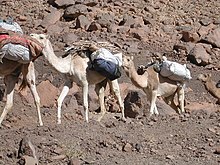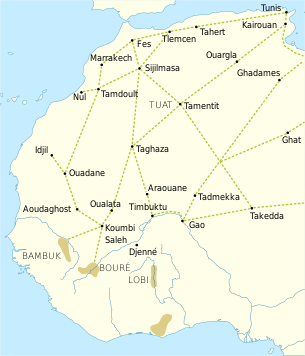Trans-Saharan Trade


As a Trans-Saharan trade the trade is called, of the Western Central Africa with the Mediterranean world combined.
Trans-Saharan trade in ancient times
The origins of trade between West Africa and the Mediterranean region have long been in the dark. It was assumed that the in the eastern Sahara since 1000 BC. And in the west since 700 BC Horses and chariots captured on rock carvings played a certain role in the movement of goods. The low load-bearing capacity of these wagons and the large amount of water used by the horses are likely to have ruled out a complete crossing of the Sahara with these means of transport. Herodotus reports in the 5th century BC By the Garamanten , who hunted black Africans with their chariots. Often it was seen, probably wrongly, as a first direct reference to the Trans-Saharan slave trade . In contrast, given the more favorable climatic conditions in antiquity, donkeys and mules may have played an important role in crossing the Sahara.
In gold , ivory and slaves were seen mostly the main exchange products. Recent archaeological and ethno-historical studies indicate that the slave trade on Bornustraße was founded by Punic traders from Carthage in the 6th century BC. It was only after these impulses from the north that the Garamanten rose to become the most important middlemen of the trans-Saharan trade. The decline and destruction of Carthage in 146 BC BC probably did not have a major impact on trade, especially as the strong Roman demand for products from the south continued undiminished. Slaves , gold and exotic animals were particularly valued for the Roman circus fights . Ptolemy mentions in the 2nd century AD an expedition by the king of the Garamanten south to Agisymba to subjugate the insubordinate inhabitants of this land. Research in recent years suggests that Agisymba is to be regarded as a precursor of the Kanem empire . The increasing spread of the camel in North Africa , which possibly as early as the 17th century BC, was of great importance for the upswing of the Trans-Saharan trade . It was introduced into Egypt but was not widely used in the Sahara until the 4th century AD.
Trans-Saharan trade in the Middle Ages
From the 5th century onwards, the rise of the Ghanaian Empire in the western Sahara saw a renewed boom in trade. With the emergence of a social upper class in the Niger - Senegal area, the demand for luxury goods from the north increased significantly. The intensification of trade was also facilitated by the state protection of Ghana. In exchange for the gold of the Wangara , the North African traders mainly supplied salt from the salt pans of Taghaza ( northern Mali) and Idschil (western Mauritania), as salt was very popular in tropical West Africa (see also salt caravans in the Sahara ). The end point of trade in the Maghreb was Sidschilmasa until the 11th century . On the Bornus Strait between Lake Chad and Tripoli , slaves have been the most important export product since ancient times. Salt came from the oases of Bilma and Fachi in this area . The most important import products from North Africa were horses , fabrics and weapons . Up until the 12th century, Ibadite groups from North Africa played an important role within the trade networks . The knowledge comes from Arab travelers such as Ibn al-Faqih (beginning of the 10th century), Yāqūt ar-Rūmī (end of the 12th century) and Ibn Battūta (14th century), who often report on a form of silent trade that is in part legendary .
Under the Songhaire empire , Timbuktu rose from 1450 on the Niger to become the most important trading center in the Sahel . Due to the close contacts with the Maghreb, it also became the center of Islamic culture in western Africa (cf. the clay mosques of Timbuktu ). However, the Songhai Empire was 1591 by an invasion of from today's Morocco derived Saadier smashed. The collapse of the state led to a considerable impairment of trade in the western Sahara, since as a result there was no regulatory power that could secure the trade routes.
Trans-Saharan Trade in Modern Times
The political stability and the security of the movement of goods in Hausaland and Bornu , on the other hand, justified an upturn in trade on Bornustraße. Even the gold of the Ashanti found its way partly via the house states to North Africa. Overall, however, the West African gold trade was mainly affected by competition from the Portuguese and later also from other European nations on the West African coast. Nevertheless, the trans-Saharan trade was able to maintain its economic importance for the empires in the Sahel region until the middle of the 19th century. After that, the ban on the slave trade , which was slowly implemented in the Ottoman Empire , began to increasingly affect the previously flourishing trade in the Sahara. Even on the side routes - from today's Chad to Benghazi in Cyrenaica - trade largely came to a standstill, even before the beginning of the colonial era. The French attempt to build a trans-Saharan railway line from Algiers or Tunis over the Ahaggar Mountains to Timbuktu failed because of the resistance of the Tuareg , as they saw their trade monopoly and thus their livelihoods at risk. With the colonial subjugation of Northwest Africa by France , the trade and economic relations of Inner Africa were finally aligned with the coastal areas on the Atlantic .
literature
- Albert Adu Boahen , Britain, the Sahara and the Western Sudan, 1788–1861. Oxford 1964.
- Edward William Bovill: The Golden Trade of the Moors . 2nd edition, revised and with additional material by Robin Hallett. Oxford University Press, London 1968.
- Jean Devisse: Routes de commerce et échanges en Afrique occidentale en relation avec la Méditerrannée. Essay on le commerce africain mediéval du Xie au XVIe siècle. In: Revue d'histoire économique et sociale. 1, 1972, pp. 42-73 et al. 357-397.
- Jean Devisse: Trade and Trade Routes in West Africa. In: M. El-Fasi (Ed.): Africa from the Seventh to the Eleventh Century. (= UNESCO General History of Africa. 3). London / Berkeley, Cal. 1988, pp. 367-434.
- Raymond Mauny: Tableau géographique de l'ouest africain au moyen âge, d'après les sources écrites, la tradition et l'archéologie. Dakar 1961.
- Elizabeth Savage (Ed.): The Human Commodity: Perspectives on the Trans-Saharan Slave Trade. London 1992.
- John T. Swanson: The Myth of Trans-Saharan Trade during the Roman Era. In: The International Journal of African Historical Studies. 8 (1975). Pp. 582-600.
- Klaus Polkehn : Under the spell of the Sahara. Brockhaus Verlag, Leipzig 1969.
- Volker Stamm : The economy of the arable farmers, cattle farmers and fishermen: Basic features of an agricultural history of the West African savannah region (approx. 1000 - approx. 1900) . Berlin [u. a.], De Gruyter, Oldenbourg. ISBN 978-3-11-058219-2 .
Web links
- Dierk Lange: "West Africa and the Classical World - neglected contexts" (PDF; 1.2 MB) in: H. Bley et al. (Ed.), Africa in Context: References to the World in Past and Present , 19th International Conference of the VAD, Hanover 2004, 20 pp. (Trans-Saharan trade in antiquity).
- "Trans-Saharan trade" , homepage with further links.
Individual evidence
- ↑ Cf. Tadeusz Lewicki : Art. "Al-Ibāḍīya" in The Encyclopaedia of Islam. New Edition Vol. III, pp. 648a-660b. Here p. 657a.
